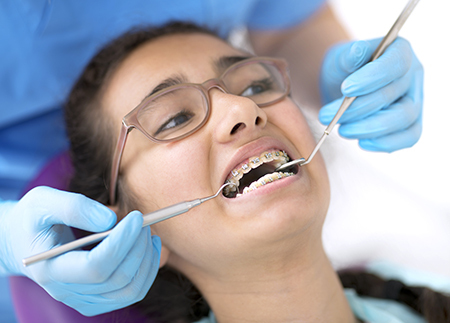 When children start losing their baby teeth, a picture of what their “new” smile will look like begins to appear. Whether their teeth start coming in crooked, they present an imperfect bite or other misalignment starts showing from habits like thumb sucking, orthodontic treatment can help reshape and create a nice-looking smile.
When children start losing their baby teeth, a picture of what their “new” smile will look like begins to appear. Whether their teeth start coming in crooked, they present an imperfect bite or other misalignment starts showing from habits like thumb sucking, orthodontic treatment can help reshape and create a nice-looking smile.
Orthodontic treatment is not limited to children — many adults seek out the services of an orthodontist to straighten their smile and treat existing bite issues that either occurred or heightened later in life.
Chung H. Kau, DDS, Ph.D., chair and professor of orthodontics in the University of Alabama at Birmingham School of Dentistry, sheds light on what types of orthodontic treatment exist, how to tell when your child is ready for braces and more.
Q: How does a parent know if their child needs to see the orthodontist?
The American Association of Orthodontists recommends a child visit an orthodontist as early as age 7 to help with development of the dentition or growth of the jaw; typically children begin orthodontic treatment like braces from ages 8 to 14.
Most often, a child will be referred to an orthodontist by a general dentist, so it is important to make sure children have regular check-ups twice a year.
However, the AAO recommends that parents be on the lookout for the following, which often indicates that it is time to visit an orthodontist for a consultation:
- Oral fixations like thumb sucking
- Crossbite (overlapping) of front or back teeth
- Protrusion, or teeth facing horizontally or at an angle
- Open bite, where front and back teeth do not meet when closed
- Crowding of teeth
- Overbite or underbite
- Noticeable spacing in between teeth
Q: What are the benefits of orthodontic treatment?
The biggest benefit I see in patients who undergo orthodontic treatment is that it visibly changes their look. Orthodontic treatment can transform a patient’s demeanor entirely from someone who was once shy and reserved, to someone who cannot stop smiling and is happy and confident.
Most importantly, orthodontic treatment helps to make a healthy smile. When a person’s jaw is offset or their teeth are misaligned, it can cause other serious dental and health effects, like gum disease, tooth decay, tooth loss or more severe jaw abnormalities.
Q: What are some of the most common orthodontic treatments available?
At UAB, our Department of Orthodontics’ clinic is a comprehensive and multidisciplinary clinic that covers a wide range of treatments; this includes early phase orthodontia, routine orthodontic care, surgical orthodontics and craniofacial care. We use a wide range of appliances, from metal and clear fixed braces and clear aligners like Invisalign, to temporary anchorage devices and class II bite jumpers.
In our 22-chair clinic, we have state-of-the-art 3D radiographs and 3D intra-oral scanning devices to capture tooth structures, and treat simple to complex malocclusions that include surgery to the jaws, impacted teeth, complex malocclusions and early treatment.
Q: Are braces just for kids?
It is never too late to have a great smile. We welcome patients of all ages. Adults often worry that they have to have traditional bracket metal braces, which isn’t always aesthetically appealing to many when in the workplace or socially. A great alternative to braces is clear aligners like Invisalign that can give someone the smile they are looking for but with more privacy.
Generally, all adults can be candidates for orthodontic treatment, but the primary reservation is that they should not have active pathology like dental decay or gum disease.
A lot of the patients we see as adults have some sort of dental or facial irregularity, which lends itself to multidisciplinary services within the school to help them get the smile they need and want.
